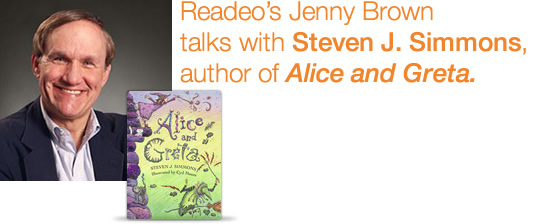


Readeo’s Jenny Brown Talks with Steven J. Simmons, author of October’s book of the month, Alice and Greta.
Steven J. Simmons is a cable television entrepreneur by day, a writer by night, and the father of five children (now just off to college) ’round the clock. Here he discusses his starring good witch and bad witch, plus the “brewmarang principle.”
Where did the idea come from for the story of Alice and Greta?
I was playing on a hill behind our house with my daughters Sarah, Caroline and Julia. A story came into my head about two witches, one a good witch and one a bad witch. We play-acted the story, and from that beginning, Alice and Greta were born. I drafted it over 20 times before it was published. It’s a lot of work.
Did you always picture a good witch and a bad witch? Or did that evolve?
Yes. They went to the same witch school but got different things from it. Alice would be doing good things for people, and Greta would be playing naughty tricks, and eventually they’d come to a playground where the climactic scene takes place. Greta plays a nasty trick, and Alice comes to the rescue and gets stuck as well. Then Alice remembers the brewmarang principle: “Whatever you chant, whatever you do, sooner or later, comes back to you.”
Do you think Alice and Greta always have a choice about how they use their knowledge?
Yes, I think they do have a choice. Alice chooses to do good things; Greta chooses to do bad things. Some interesting things happen to the characters in the sequel, Greta’s Revenge—they switch characters, and come back to themselves. Everyone is responsible for his or her behavior.
We liked when Alice turns the frog into a prince and Greta turns the prince back into a frog. Did you talk with Cyd Moore while you were working on the book?
I found Cyd Moore. I looked in bookstores, looked at artists’ portfolios. Her drawings captured what I wanted. They were whimsical but had lots of character and a sense of humor. In the pictures there are some witty things.
Both Alice and Greta see the same view—but one sees good things, the other bad. How do their actions shape their outlook?
I think people’s perceptions have a lot to do with their upbringing, the people they spend time with, and their experiences in life. Ultimately, people need to take responsibility for their own actions. If we do treat others as we’d like to be treated, the world will be a better place, and in the end we’ll all be happier and fulfilled.
It sounds like you believe in the “brewmarang principle.”
I do believe in the brewmarang principle. No one’s perfect. I understand that it’s hard to do this 100% of the time, but I think as close as we can come to doing it all the time, the better off we’ll be.


Comments are closed.